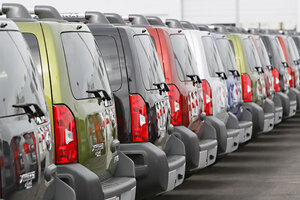Retail sales get a boost from autos, gas prices
Retail sales rose in August because consumers paid higher gas prices and bought more cars and trucks. Retail sales at general merchandise, clothing and electronic stores fell, suggesting that consumers are becoming more selective about spending.

This February 2012 file photo shows a long line of 2012 Xterras at a Nissan dealership in the south Denver suburb of Englewood, Colo. Strong auto sales and high gas prices boosted retail sales in the US to an overall increase in August.
David Zalubowski/AP/File
Washington
U.S. retail sales rose in August because consumers paid higher gas prices and bought more cars and trucks. They were more cautious elsewhere, suggesting the weak economy has made many selective about spending.
Retail sales increased a seasonally adjusted 0.9 percent from July, the Commerce Department said Friday. Gas station sales jumped 5.5 percent, the most in nearly three years and a reflection of sharp price increases. Demand for autos increased 1.7 percent.
Outside those categories, sales rose only 0.1 percent. That's below July's 0.8 percent gain. Sales at general merchandise, clothing and electronic stores fell. Sales at grocery stores, sporting goods stores and online retailers were unchanged.
The retail sales report is the government's first look each month at consumer spending, which drives roughly 70 percent of economic activity. Consumer spending has increased at a slow pace this year. That has dragged on the economy and kept businesses from hiring.
Gasoline sales are heavily influenced by price, and auto sales represent major purchases. Excluding those categories offers more clarity on consumers' willingness to spend.
"This has to go down as a weak report," said Paul Dales, senior U.S. economist at Capital Economics. "Most of the spending in August was on products that households have to buy, such as gasoline, not items they like to buy, such as new TVs."
Higher gas costs also drove up consumer prices by the most in three years, the Labor Department said in a separate report. But excluding energy prices, inflation was mild.
Consumer prices rose 0.6 percent in August, the department said. Gas prices increased 9 percent and accounted for 80 percent of the increase. Outside food and energy, prices rose only 0.1 percent.
Overall consumer prices have increased 1.7 percent in past year. That's well below the Federal Reserve's inflation target.
Lower inflation will allow the Fed to stick with programs announced Thursday aimed at lifting the economy. If the central bank is worried that prices are rising too fast, it might have to raise interest rates.
On Thursday, the Federal Reserve said it would buy $40 billion of mortgage-backed securities a month until the economy and job market show signs of steady improvement. Fed officials also said they would keep short-term interest rates low, even after the acceleration of any economic recovery.
Rising gas prices could make consumers more cautious about spending in the coming months. Gas prices averaged $3.87 a gallon (3.7 liters) nationwide on Friday, 16 cents higher than a month ago and just 7 cents below the 2012 average high.
Automakers earlier this month reported the best sales in three years, after seeing rising demand for pickup trucks.
The government's retail sales data contrasted with reports from the nation's largest retail chains. Many said things picked up in August, driven partly by back-to-school purchases. Sales at 18 retail chains rose last month by the most since March.
Employers added only 96,000 jobs last month, below the 141,000 added in July and far below the average gains of 226,000 in the first three months of the year.
The unemployment rate fell to 8.1 percent from 8.3 percent, but only because the number of people in the work force shrank.
The economy is growing too slowly to spur greater job gains. The economy expanded at a 1.7 percent annual pace in the April-June quarter. That's down from 2 percent in the first quarter and 4.1 percent in the final three months of last year.

